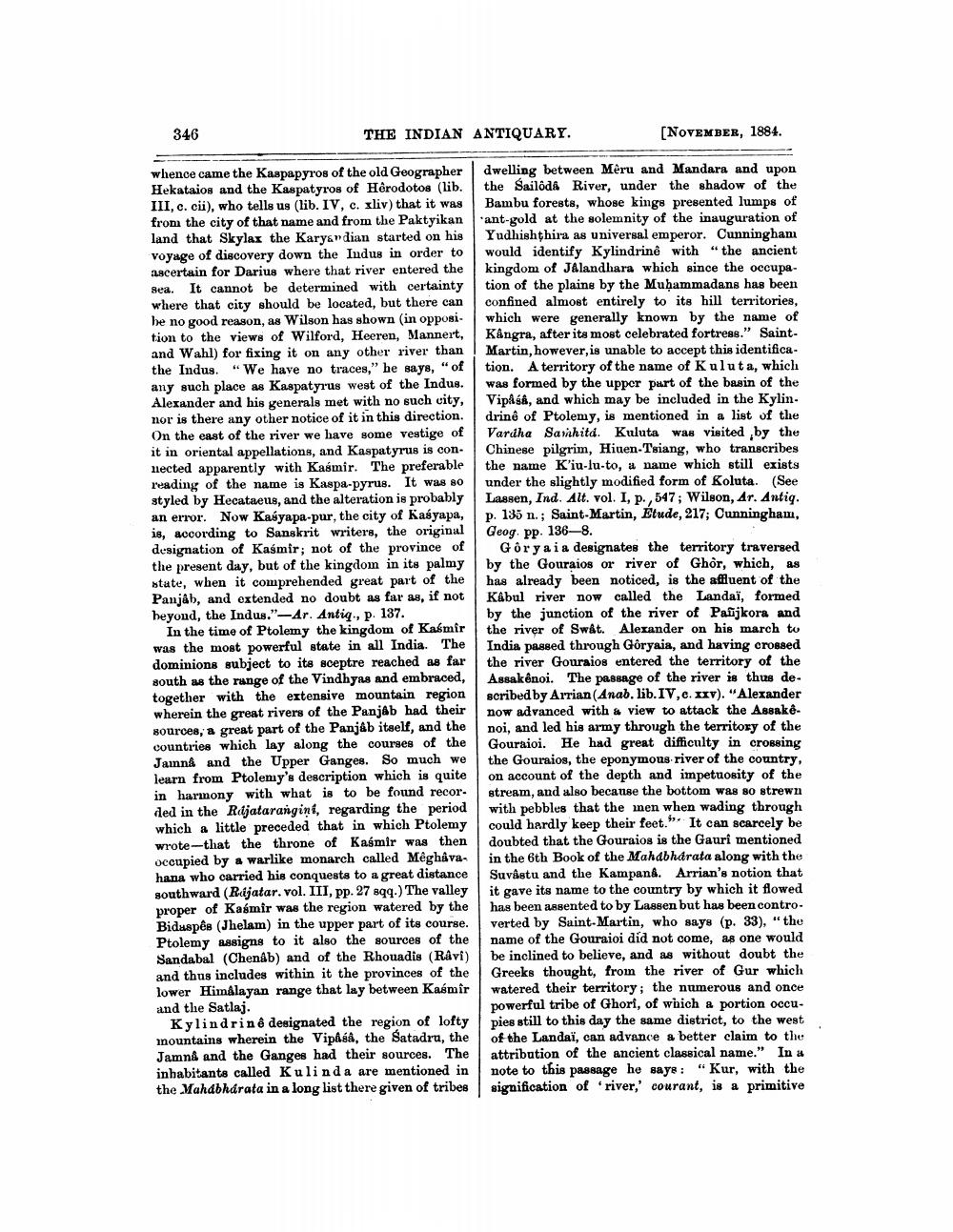________________
346
THE INDIAN ANTIQUARY.
[NOVEMBER, 1884.
whence came the Kaspapyros of the old Geographerdwelling between Meru and Mandara and upon Hekataios and the Kaspatyros of Herodotos (lib. the Sailoda River, under the shadow of the III, c. cii), who tells us (lib. IV, c. xliv) that it was Bambu forests, whose kings presented lumps of from the city of that name and from the Paktyikan 'ant-gold at the solemnity of the inauguration of land that Skylax the Karyar dian started on his Yudhishthira as universal emperor. Cunningham voyage of discovery down the Indus in order to would identify Kylindrinê with "the ancient ascertain for Darius where that river entered the kingdom of Jalandhara which since the occupasea. It cannot be determined with certainty tion of the plains by the Muhammadans has been where that city should be located, but there can confined almost entirely to its hill territories, be no good reason, as Wilson has shown in opposi. which were generally known by the name of tion to the views of Wilford, Heeren, Mannert, Kångra, after its most celebrated fortress." Saintand Wahl) for fixing it on any other river than! Martin, however, is unable to accept this identificathe Indus. “We have no traces," he says, "of tion. A territory of the name of Kuluta, which any such place as Kaspatyrus west of the Indus. was formed by the upper part of the basin of the Alexander and his generals met with no such city, Vipasa, and which may be included in the Kylin. nor is there any other notice of it in this direction. drinê of Ptolemy, is mentioned in a list of the On the east of the river we have some vestige of Vardha Sarhitd. Kuluta was visited by the it in oriental appellations, and Kaspatyrus is con- Chinese pilgrim, Hiuen-Tsiang, who transcribes nected apparently with Kasmir. The preferable the name K'iu-lu-to, a name which still exists reading of the name is Kaspa-pyrus. It was 80 under the slightly modified form of Koluta. (See styled by Hecataeus, and the alteration is probably Lassen, Ind. Alt. vol. I, p., 547; Wilson, Ar. Antig. an error. Now Kasyapa-pur, the city of Kasyapa, p. 135 n.; Saint-Martin, Etude, 217; Cunningham, is, according to Sanskrit writers, the original Geog. pp. 136–8. designation of Kaśmir; not of the province of Górya ia designates the territory traversed the present day, but of the kingdom in its palmy by the Gouraios or river of Ghòr, which, as state, when it comprehended great part of the has already been noticed, is the affluent of the Panjab, and extended no doubt as far as, if not Kábul river now called the Landai, formed heyond, the Indus."-Ar. Antiq., p. 137.
by the junction of the river of Pafijkora and In the time of Ptolemy the kingdom of Kaśmir the river of Swát. Alexander on his march to was the most powerful state in all India. The India passed through Góryaia, and having crossed dominions subject to its sceptre reached as far the river Gouraios entered the territory of the south as the range of the Vindhyas and embraced, Assakénoi. The passage of the river is thus de. together with the extensive mountain region scribed by Arrian (Anab. lib. IV, c. XIV). "Alexander wherein the great rivers of the Panjab had their now advanced with a view to attack the Assakesources, a great part of the Panjab itsell, and the noi, and led his army through the territory of the countries which lay along the courses of the Gouraioi. He had great difficulty in crossing Jamna and the Upper Ganges. So much we the Gouraios, the eponymous river of the country, learn from Ptolemy's description which is quite on account of the depth and impetuosity of the in harmony with what is to be found recor. stream, and also becanse the bottom was so strewn ded in the Rejatarangini, regarding the period with pebbles that the men when wading through which a little preceded that in which Ptolemy could hardly keep their feet.". It can scarcely be wrote that the throne of Kasmir was then doubted that the Gouraios is the Gauri mentioned occupied by a warlike monarch called Mégháva in the 6th Book of the Mahabharata along with the hana who carried his conquests to a great distance Suvastu and the Kampana. Arrian's notion that southward (Rijatar. vol. III, pp. 27 sqq.) The valley it gave its name to the country by which it flowed proper of Kasmir was the region watered by the has been absented to by Lassen but has been contro. Bidaspês (Jhelam) in the upper part of its course. verted by Saint-Martin, who says (p. 33), "the Ptolemy assigns to it also the sources of the name of the Gouraioi did not come, as one would Sandabal (Chenåb) and of the Rhouadis (Råvi) be inclined to believe, and as without doubt the and thus includes within it the provinces of the Greeks thought, from the river of Gur which lower Himalayan range that lay between Kasmir watered their territory; the numerous and once and the Satlaj.
powerful tribe of Ghori, of which a portion occuKylindrinê designated the region of lofty ! pies still to this day the same district, to the west inountains wherein the Vipasa, the Satadru, the of the Landai, can advance a better claim to the Jamni and the Ganges had their sources. The attribution of the ancient classical name." In a inhabitants called Kulinda are mentioned in note to this passage he says: "Kur, with the the Mahabharata in a long list there given of tribes signification of river, courant, is a primitive




